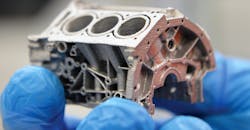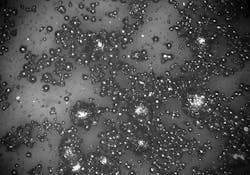Metallurgy Breakthroughs Show a New Phase of Competition
A well-designed, well-produced casting is proof of its own value, but buyers’ demands go beyond design and production. That’s an opening for proponents of 3D-printing, who lately are making their intentions known – not with new design or production capabilities but with metallurgy, long assumed to be the real advantage that foundries and diecasters held in this competition.
Desktop Metal Inc. CEO Ric Fulop called his group’s co-development of an aluminum 6061 powder for binder-jet additive manufacturing a “breakthrough … one of the most sought-after materials for use in automotive, aerospace, and consumer electronics.” Desktop Metal and partner Uniformity Labs claim their new alloy offers greater than 10% elongation plus improved yield strength and ultimate tensile strength compared to wrought aluminum 6061.
The alloy, Uniformity 6061, is proceeding toward qualification and a commercial release. Adam Hopkins, Uniformity Labs founder and CEO said the new alloy “opens the door to a wide variety of thermal and structural applications across industries.”
The developers said the new powder makes it possible to sinter unadulterated 6061 aluminum, meaning it is not necessary to coat powder particles prior to printing, nor to mix sintering aids into the powder, nor to use binders containing expensive nanoparticles or metals.
At nearly the same time another “breakthrough” for binder-jet printing of aluminum 6061 was announced by AM developer ExOne Co. and Ford Motor Co., who have been collaborating on the development since 2019. They are seeking to patent a 3D-printing and sintering process which they claim, “delivers properties comparable to diecasting.”
Aluminum 6061 contains magnesium and silicon elements, and it features good mechanical properties and good weldability. It is commonly extruded, forged, and sometimes diecast. Ford and ExOne contend their process for binder-jet printing and sintering aluminum 6061 results in parts with densities greater than 99%.
“High-speed aluminum 3D-printing paves the way for other opportunities that we’re just now starting to take a look at because of the ability to do complex parts with aluminum that previously weren’t possible,” according to Harold Sears, Ford technical leader for additive manufacturing. “It’s really opening doors for other opportunities.”
ExOne noted that new process could increase Ford’s efficiency by allowing it to affordably produce complex parts uniquely designed for additive manufacturing, which could mean “size and weight reductions, part consolidation, and performance improvements.”
“Developing a fast, affordable, and easy way to 3D-print aluminum with traditional material properties is a critical step toward light-weighting more products and delivering a more sustainable future,” stated John Hartner, ExOne CEO.
Another frontier in this competition sees AM specialist 3D Systems collaborating with Huntington Ingalls Industries’ Newport News Shipbuilding division to develop copper-nickel (CuNi) and nickel-copper (NiCu) alloys for powder-bed fusion (a/k/a “binder jet”) production – potentially allowing NNS to replace castings with additively manufactured parts, and to cut lead times by up to 75%.
CuNi and NiCu are corrosion-resistant alloys with high strength and durability across a wide range of temperatures. However, components produced in these alloys require long lead times (sometimes more than one year, according to 3DS) and multiple suppliers. A successful powder-metal formulation that could be available for metal 3D printing could shorten the supply chain considerably, it is proposed.
Newport News Shipbuilding is the sole designer, builder, and refueler of U.S. Navy aircraft carriers and one of two providers of U.S. Navy submarines. It would be able to use the new materials with its current metal AM capabilities to produce replacement parts for castings, as well as valves, housings, and brackets.
Once the CuNi and NiCu materials have been demonstrated successful, 3D Systems anticipates they will be added to its materials portfolio and would be available for corrosion-resistant applications in other industries, like oil-and-gas production and refining, and utility energy production.
The metallurgy of powdered materials may be the emerging venue for the ongoing competition between metalcasting and other manufacturing processes – a contest that buyers will settle.

